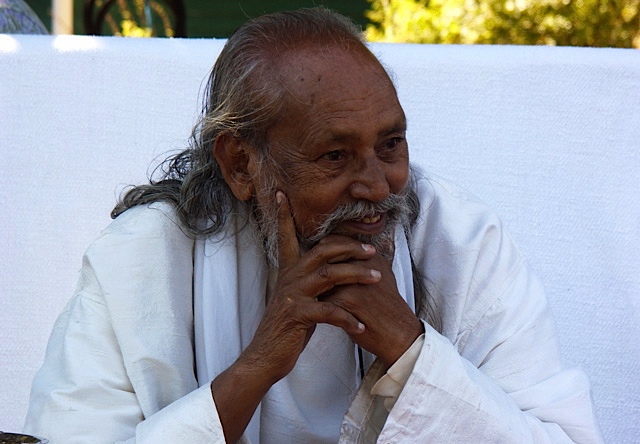Regular Sadhana (Spiritual Practice)

Over the course of many years Babaji has often responded to students’ anxious questions with the recommendation to do regular sadhana, later shortened on his chalkboard to RS.
Sadhana, or spiritual practice, comes in many forms. Many people have a committed asana practice, and that is one expression of sadhana, as is the practice of karma yoga or developing positive qualities.
Generally, when Babaji uses the term ‘regular sadhana’, he is referring to the daily time that one sets aside for a meditation practice, a time each morning that is designated to withdrawing the mind from its preoccupation with the outer world, holding the intention of being still within .
Most of us, when we sit, are not actually practicing meditation. What happens when we first begin to sit is that we notice we are not sitting in stillness; rather we are quieting down enough to notice how out of control our minds are. Our thoughts wander all over the place, bouncing from one subject to another – very disconcerting.
All the limbs of classical Ashtanga Yoga serve as supports in becoming able to sit and still the mind. A daily practice of asana along with mindful breathing can develop flexibility in the body and concentration in the mind. Pranayama (breath control) helps steady the mind, which in turn supports pratyahara, the withdrawing of the mind from its preoccupation with the senses. This leads to the ability to practice dharana (concentration), leading to dhyana (meditation) and eventually samadhi (merging with the Self or source).
For a regular meditation (or at least sitting) practice, it is more useful to sit for a set period of time every day, even if it’s only 10 minutes to begin with, than to sit for an hour one day and none for the next several days. Sitting regularly develops the habit of sitting regularly. The commitment and discipline alone create changes that we may not be aware of, and over time we may begin to notice that we’re calmer, more tolerant, less reactive – maybe not every day, but increasingly over time. In “Silence Speaks” Babaji says, Regular sadhana works inside the body and mind very slowly. One should not be disheartened by apparent lack of progress in sadhana. There is always progress but we can’t feel it, just as when an airplane is high in the sky and going very fast we can’t feel its speed. The progress is felt at takeoff and landing.
From Patanjali’s Yoga Sutras, book 1, sutra 14: Persistent practice becomes firmly grounded when it has been practiced for a long, uninterrupted time with earnest devotion.
There is no definition of “long, uninterrupted time”; all we can do is commit to a practice and then do it regularly. As Babaji says in Everyday Peace: Keep the lamp lit, walk on step by step. You can’t go astray, but will merge in the light.
—
contributed by Sharada
